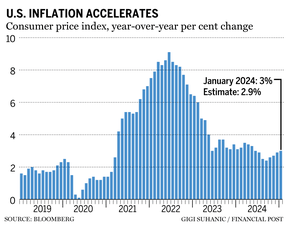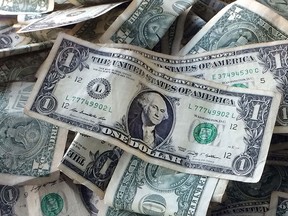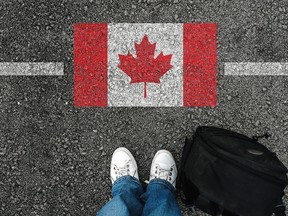Here’s what economists are saying about the latest CPI numbers stateside
Article content
Inflation in the United States appears to be heading in the wrong direction, which has some economists worried that the U.S. Federal Reserve could end up hiking interest rates.
Article content
Article content
Headline inflation increased three per cent year over year in January, according to the U.S. Labor Bureau’s consumer price index (CPI), which was higher than analysts’ forecast of 2.9 per cent.
Advertisement 2
Article content
It was the fourth headline increase after the CPI hit a post-pandemic low of 2.4 per cent in September.
Markets cut their rate-cut bets in half to just one by the Fed in 2025, following the release of the hotter-than-expected data.
Some economists said the overheated numbers were due to seasonal effects since many businesses implement price increases at the start of the year.
Others say the numbers point to an overall trend of rising costs.
That will worry Americans, but it should also bother Canadians because higher U.S. interest rates could continue to push the Canadian dollar lower against its U.S. counterpart. U.S. interest rates are used to set borrowing costs for mortgages in Canada.
Royce Mendes, managing director and head of macro strategy at Desjardins Group, said that persistently higher inflation in the U.S. could end up leaching into Canada given the two economies’ high level of integration.
And that’s not all that could bedevil Canada.
“Stronger price pressures stateside could also be bad news for Canada if the Fed isn’t able to lower rates this year since it could, at the margin, restrain the Bank of Canada’s ability to cut rates as much as it might have otherwise,” Mendes said in an email.
Article content
Advertisement 3
Article content
“While Canadian central bankers believe that domestic monetary policy has not reached its limits in terms of divergence with the U.S. policy, there is a limit somewhere.”
Here’s what economists think the inflation data means for the Fed and its future path on interest rates.

Risks of a hike rising: Bank of Montreal
“Not much to like in today’s January CPI report,” Scott Anderson, the Bank of Montreal’s chief U.S. economist, said in a note. “The moderation we saw in consumer inflation last summer is no longer visible now.
He said U.S. inflation appears to have reaccelerated after the Fed cut interest rates by a total of 100 basis points late last year and so “finger pointing on the rate cuts will intensify, and market pressures will build on the Fed to stay on hold for a considerable period of time before contemplating another cut.”
The data bears that out.
Three-month annualized core inflation, which excludes food and energy, was running at 3.8 per cent, while super-core inflation, which measures services costs minus energy and shelter, was 5.3 per cent, well above the Fed’s two per cent target.
Advertisement 4
Article content
Fed chair Jerome Powell on Tuesday told a U.S. Senate committee he was in no rush to cut rates. He repeated that message Wednesday during his testimony before the House of Representatives’ financial services committee.
The latest CPI data amps up that message, given it looks like the Fed is now dealing with “a real multi-month firming of inflation pressures,” Anderson said. “The risk of Fed rate hikes, while still low, is going up.”
‘Hawks have upper hand’: Rosenberg Research
“Bond and stock markets will not like this number one bit, and neither will the Fed — with the hawks having the upper hand,” David Rosenberg, founder of Rosenberg Research & Associates Inc., said in a note.
He pointed out that the evidence of inflation was widespread, despite a strong U.S. dollar. For example, used car prices and insurance spiked, and so did airfares and recreation service costs, as well as food and drug prices and rents.
There were signs of deflation in some segments, but those only account for a smaller piece of the CPI pie, Rosenberg said.
“Keep in mind that all of this is taking place in advance of the tariff effects,” he said.
Advertisement 5
Article content
U.S. President Donald Trump is currently enjoying a strong approval rating, which Rosenberg thinks will embolden him to push ahead on tax cuts, posing another upside risk to inflation.
“So, with all that in mind, one can no longer dismiss the odds that not only is the Fed on hold now indefinitely, but that the next move could well be a rate hike,” he said. “Not my base case, but the odds are now hardly trivial and just took a move up on today’s report.”
Rates on hold for 2025: Capital Economics
“Inflation … clearly isn’t coming down decisively any more,” Paul Ashworth, chief North America economist at Capital Economics Ltd., said in a note.
With Trump threatening tariffs, which are considered inflationary, the economist thinks the Fed will hold interest rates for the rest of the year.
Recommended from Editorial
-

Summers sees biggest inflation-breakout risk since 2021
-

U.S. inflation accelerates, cutting chances for Fed rate cuts
-

Powell says Federal Reserve in no rush to lower rates
Ashworth estimates the latest CPI data, coupled with tomorrow’s producer price index release, will leave the Fed’s preferred inflation measure — the personal consumption expenditure index — higher than policymakers like.
“The upshot is that markets are now only pricing in one 25-basis-point rate cut by the Fed this year,” he said. “We still think that’s too dovish,” and that cuts are “off the table” in 2025.
• Email: gmvsuhanic@postmedia.com
Bookmark our website and support our journalism: Don’t miss the business news you need to know — add financialpost.com to your bookmarks and sign up for our newsletters here.
Article content
Fed rate hike risk rises on hotter inflation
2025-02-12 18:46:11







